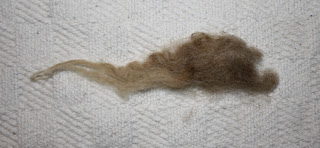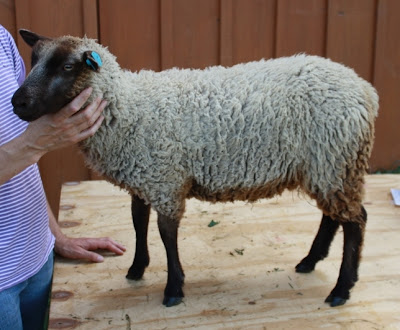First of all, it’s not unusual to encounter double-coated Shetlands on your Shetland journey in the US. There is absolutely nothing wrong with a double-coated Shetland. They are common. What you need to determine is what you want to do with the fleece. Below is an example of a double-coated Shetland fleece.
This sample is very straight and coarse. But it has nice luster, which is to say it’s silky. It will spin up very well. But you would never want to use it in next-to-the-skin garments. It’s far too coarse for comfort. And without crimp, it lacks the elasticity that you want for some projects. This particular sample is about 34 microns on average, and the CV is over 30%, but not much over. This fleece is about 9" long.
It is not a breed standard Shetland fleece by any stretch of the imagination, but that doesn’t mean it is bad, necessarily. But I can’t see using it for anything other than rugs. I think it's an example of the type of fleece that starts a lot of arguments between breeders. When you say something does not meet the breed standard, people take exception to it, but, in my opinion, this one doesn't. Why? For one, 34 microns is too coarse. Shetlands are supposed to be fine. Secondly, there is not crimp here. Some might try to argue that it's wavey (which is what the breed standard calls out), but that's equivalent to saying blue is almost green. This fleece has no movement at all in the finished product. It has no elasticity whatsoever.
Now, given that this sample has two very distinct coats, you could easily spend the time to separate them and then the finer inner coat could be used for clothing, but it will still lack the elasticity that you desire. As I said, it comes down to what you want to do with the fleece. But the bigger question might be why would you choose Shetland if you are making rugs and/or other items that require extra durability, without crimp?
The next sample is also double-coated, but not as extreme. I’ve seen Shetland fleeces ranging from 2” to 16”, and this one is closer to 6”. It has good luster, but also lacks crimp like the first example.
In terms of fineness, it is about 32 microns with a 30% CV. It’s certainly not my ideal, but it is pretty silky, and doesn't feel as coarse as the first sample. You can do a bit more with this fleece than the last one, because the outer coat (guard hair) isn't as dominant, but it still lacks the crimp to really provide good elasticity to projects. And I know there are things you can do during the spinning process to compensate for the lack of crimp, but when you compare it to finer fleeces, there is a very noticeable difference. In terms of spinning properties, it's probably equivalent to the first sample. Both will spin up easily, which makes them a favorite of beginning spinners.
To sum up the first two samples, both are Shetland, but not particularly good examples of the breed. If these fleeces were the norm in the old days in Shetland, the breed would not have been called the finest of the British breeds. That's not to say they didn't exist, however.
Next is a sample of a fleece that I think is a pretty good example from an adult Shetland. You can see distinct crimp here. The staple is 4", which is what I have found to be a good length. As far as fineness, this one is about 29 microns with a 23% CV. Not bad at all. Nice luster, but not as nice as others that I've seen. Having made products from this fleece, I can say we are pretty satisfied with it. You might say that 29 microns is at the very upper limit of what wool authorities would call fine, and you'd be correct. But you have to evaluate fleeces against multiple criteria, and this one grades out pretty well overall. It has a lot of good properties. And coming from a three-year old ewe, this is not bad at all. There are two coats here, but they would be difficult to separate. If you are into separating the coats, you might be better off with a fleece that contains a more pronounced difference between them. Icelandics have such fleeces and a lot of people like them for that reason.
The next sample is from what I would call a fine fleece. This is basically what we breed for here at Whispering Pines. That doesn't mean anyone else needs to follow what we do, but I'm merely illustrating what we are after.
This fleece falls somewhere between 26 and 28 microns with a 20% CV. It’s about 4” long and you can see the crimp quite clearly. This fleece is fully functional in that is has nice luster and fineness to go along with the other classic Shetland properties. It could be used in most projects, including those requiring extra durability. It really has no limitations for use. It's not as fine as some of the best Shetland fleeces I've seen, but it's very good. This fleece would not need to be separated into two coats because there really aren't two of them.
The final sample is what I would call an extra fine Shetland fleece. It's not Merino fine, but it is still very fine.
In Shetland parlance, an extra fine fleece should have an average micron of between 21 and 24 microns. Some would disagree with my assessment on that, but I’ve seen too many really nice 24 micron fleeces to say that they are not extra fine. And yes, you can notice the difference between one of these fleeces and say an 28 micron Shetland fleece (like the one above). I also don’t think there’s much of a downside to fleeces this fine. I would think you might give up some durability with the really fine stuff, but for years, they used Shetland fleeces in the UK for shawls and other next-to-skin applications. And they were able to do that because of the versatility of the fleeces. It has properties that allow it to be used in many applications. Shetland fleeces are very unique in the totality of their properties. They aren't like Alpaca fiber. They might not be as fine as Alpaca, but they are very durable. Shetland fleeces were commonly used in the hosiery industry back in the day. And that was another thing that made them so unique. They could be used in a demanding application like that, and yet still had excellent fineness. A good Shetland fleece handles like nothing else.
Shetland fleeces can also be quite diverse. The breed itself is very diverse in terms of the various attributes that make up the breed, but fleece is one example of that. I have seen single sheep that had three types of fleeces on one animal. The neck and shoulders were kind of like the good sample above - very decent - to - good with lots of utility. Not extra fine, but still pretty good. Then by midside, you were into a fleece that resembled the second one from the top. Then, as you moved back a few inches, you were into something more like the top photo. The back half of the sheep really was very limited in terms of what you could do with it. For all intents and purposes, you started out with a three pound skirted fleece and ended up with less than a pound of what I would call decent and reasonably crimpy, and maybe another pound of fleece that wasn’t terribly coarse, but still had limited functionality. That’s just not what we breed for here, but you can find sheep like that without very much difficulty if that's what you like. As I said, it really depends on what you like in your fleeces.
In closing, here are a few other examples of extra fine fleeces with 4" staple lengths and great uniformity. And notice the classic Shetland lock structure on each one.
These fleeces might not be for everyone, but we think they represent the breed nicely. They won't be 6" long, but 3" to 4" is more typical of the breed when you get this fine. If someone can show me a fine and soft Shetland fleece that is longer than 6", I'll be very interested in that fleece. I am sure there are bloodlines like that, but I haven't come across one yet. A 6" fleece can be quite acceptable, but I wouldn't expect it to be this fine. I suppose it could be, but I think this would be the exception to the norm, based on what I have seen.
And maybe that's the final point of this post. You don't have to go super short to get extra fine. The Shetland Sheep Society allows fleeces to be as short as 2" and as long as 6". I don't care for the fleeces at those extremes, but I've seen some good stuff at those ends of the spectrum.I have been fortunate to have visited 15 Shetland farms over the years, and I have seen a lot of different types of Shetlands and fleeces. That has given me some perspective on the breed that I would not have gained otherwise. It allowed me to really fine tune my craft. And to me, breeding is a craft. It's not easy. It's not hard breeding Shetlands because they are so small and hardy, but getting fleeces like we like has not been easy. And, to be honest, we still haven't reached our goals yet, but we have had enough success to get a glimpse of what is possible with the breed. And that keeps me working at it.

























































